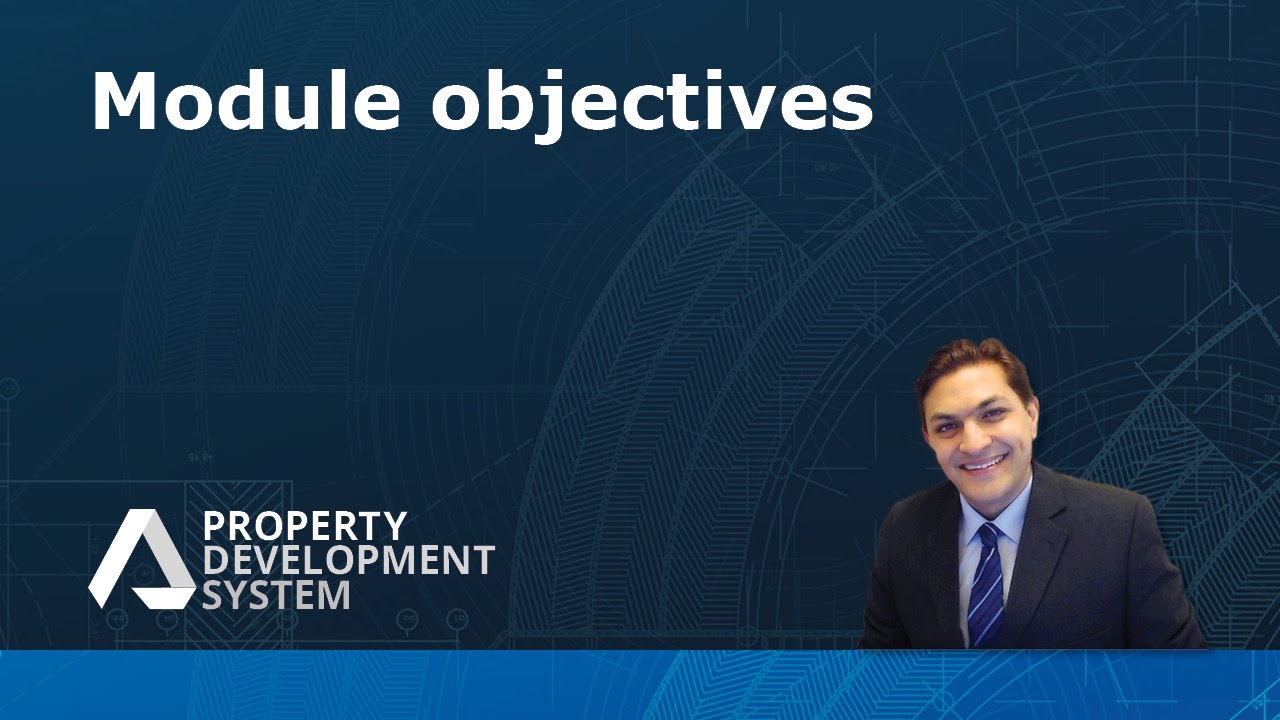Module Objectives
Here is a comprehensive introduction to understanding financial feasibility in real estate development, focusing on the strategic assessment of site value, competitive bidding dynamics, and the critical importance of accurate financial feasibilities.
It aims to equip viewers with the knowledge to make informed decisions on property development, ensuring no overpayment for land and understanding various stakeholders’ perspectives on feasibility analysis.
Financial feasibility
Understanding as Module 2’s focus.
Constraints and best use
Identifying for site/land development.
Competition reasons
Why they may pay more for land.
Cornerstone concept
Ensuring no overpayment for development sites.
Feasibility purposes
Varied for lenders and developers.
Feasibility types
Exploring three kinds with examples.
Insights based on numbers
- The module delves into four reasons competition might outbid for land, highlighting the strategic value assessment in real estate.
- It emphasises the importance of not overpaying by even a dollar more than a site’s worth, showcasing the precision needed in financial evaluations.
- The discussion covers three types of financial feasibilities, offering a comprehensive look at approaches to assess project viability.
Frequently Asked Questions
How do lenders and developers differently perceive the purpose of financial feasibility?
For lenders, the primary concern is the viability and security of their loan, ensuring that the project presents a low risk of default and that their financial interests are protected.
On the other hand, developers use financial feasibility studies to assess the potential profitability and practicality of a project, focusing on whether the anticipated return on investment aligns with their goals and the associated risks.
This differentiation in perspectives underscores the multifaceted nature of financial feasibilities, demonstrating their critical role in aligning the interests and expectations of all parties involved in real estate development projects.
What is financial feasibility in the context of real estate development?
Financial feasibility in real estate development refers to the process of evaluating a property development project to determine whether it is financially viable.
This involves assessing the costs associated with the development, including land acquisition, construction, and marketing, against the potential revenue that the completed project can generate. The focus is on ensuring that the project can be carried out profitably without overpaying for the development site.
Why is understanding constraints and best use important for site/land development?
Understanding constraints and best use is crucial for site or land development because it helps identify the most efficient and effective way to utilise a parcel of land. Constraints may include zoning regulations, environmental factors, and physical characteristics of the site, which can limit or define the possible uses of the land. Identifying the best use involves analysing these constraints to determine the most profitable and feasible development option, ensuring that the land is utilised to its full potential.
What are the reasons competitors might pay more for land?
Competitors might pay more for land for several reasons, including strategic value assessment, the potential for future appreciation, competitive positioning, and specific project needs that align uniquely with the characteristics of the site. These factors can lead competitors to perceive the land as more valuable, prompting them to outbid others in the pursuit of securing the site for their development projects.
What is the cornerstone concept of not overpaying for development sites?
The cornerstone concept of not overpaying for development sites is centred on the principle of precision in financial evaluation. It emphasises the importance of accurately determining a site’s worth and ensuring that the purchase price does not exceed this value by even a dollar. This concept is crucial for maintaining financial viability and profitability in real estate development projects.
How do the purposes of feasibility analysis vary for lenders and developers?
The purposes of feasibility analysis vary for lenders and developers because each has different interests and priorities. For lenders, the primary concern is the project’s ability to repay borrowed funds, so their feasibility analysis focuses on the risk associated with the loan. For developers, the analysis is broader, encompassing not only financial viability but also market demand, competitive positioning, and potential return on investment. Developers use feasibility studies to make informed decisions about whether to proceed with a project.
What are the three types of financial feasibilities explored in the module?
The module explores three types of financial feasibility: preliminary feasibility, detailed feasibility, and ongoing feasibility. Preliminary feasibility involves an initial assessment to determine if a project concept is worth exploring further. Detailed feasibility is a comprehensive analysis that evaluates all aspects of the project, including costs, revenue, market demand, and regulatory requirements. Ongoing feasibility refers to continuous evaluations throughout the project’s lifecycle to ensure it remains viable under changing conditions.
Test Your Knowledge
Multiple Choice Questions on Understanding Financial Feasibility in Real Estate Development
1. What is the primary focus of Module 2 on financial feasibility in real estate development?
A) Maximizing land acquisition costs
B) Strategic assessment of site value and competitive bidding dynamics
C) Increasing the profitability of real estate projects
D) Minimizing construction time and expenses
2. Identifying constraints and the best use for site/land development is crucial because:
A) It ensures that all land is used for residential purposes
B) It helps in avoiding competitive bidding altogether
C) It aids in determining the most profitable and feasible development option
D) It eliminates the need for a financial feasibility studies
3. Why might competitors pay more for a piece of land?
A) They often miscalculate the land’s true value
B) Strategic value assessment and specific project needs
C) There is a legal obligation to overpay for land in competitive situations
D) All competitors have unlimited funds
4. The cornerstone concept of ensuring no overpayment for development sites is based on:
A) The principle of averaging the costs with neighbouring sites
B) The necessity of bidding higher than competitors
C) Precision in financial evaluation
D) The assumption that all sites will appreciate in value
5. How do the purposes of feasibility analysis vary between lenders and developers?
A) They do not vary; both lenders and developers have identical interests
B) Lenders focus on the project’s ability to repay borrowed funds, while developers focus on broader aspects, including market demand
C) Lenders are only interested in the environmental impact of the project
D) Developers are solely interested in the architectural aspects of the project
6. Which of the following is NOT one of the three types of financial feasibilities mentioned?
A) Preliminary feasibility
B) Detailed feasibility
C) Ongoing feasibility
D) Retrospective feasibility
7. The module emphasises the importance of not overpaying for a site to:
A) Encourage speculative bidding
B) Showcase the precision needed in financial evaluations and ensure profitability
C) Guarantee that the development project will be completed ahead of schedule
D) Ensure that all stakeholders agree on the value of the site
8. The strategic value assessment in real estate emphasises:
A) The ability to negotiate prices below market value
B) Understanding why and how competition might outbid for land
C) The importance of developing properties with only short-term gains in mind
D) The need to focus solely on residential development projects
Answers
- B) Strategic assessment of site value and competitive bidding dynamics
- C) It aids in determining the most profitable and feasible development option
- B) Strategic value assessment and specific project needs
- C) Precision in financial evaluation
- B) Lenders focus on the project’s ability to repay borrowed funds, while developers focus on broader aspects, including market demand
- D) Retrospective feasibility
- B) Showcase the precision needed in financial evaluations and ensure profitability
- B) Understanding why and how competition might outbid for land
Assignment
Understanding Financial Feasibility in Real Estate Development
Objective:
To apply the concepts of financial feasibility in real estate development through practical exercises, ensuring a deep understanding of strategic site value assessment, competitive bidding dynamics, and the importance of accurate financial feasibilities.
Part 1: Analysis and Application
To Do:
- Site Value Assessment Exercise:
- Choose a hypothetical plot of land for development. Describe its location, size, zoning, and any other relevant features.
- Conduct a strategic assessment of the site’s value, considering factors such as market demand, potential use, and constraints. Document your methodology and final assessment value.
Competitive Bidding Scenario:
- Create a scenario where you are competing with another developer for the chosen plot of land.
- List at least four reasons why your competition might be willing to pay more for the land.
- Outline your strategy to ensure you do not overpay while still attempting to secure the plot.
Feasibility Study Types Application:
- For the same plot of land, outline a preliminary feasibility study detailing the initial assessments you would perform.
- Propose a structure for a detailed feasibility study, including key financial metrics and analyses you would examine.
- Discuss how ongoing feasibility assessments could be integrated into the project development lifecycle.
Part 2: Research and Reflection
Stakeholder Perspectives:
- Investigate how different stakeholders (e.g., local government, community organisations, lenders, and developers) view financial feasibility in real estate development.
- Provide a summary of each perspective and discuss how these viewpoints could impact the development process for your chosen site.
Real-World Feasibility Analysis:
- Find a case study of a real estate development project that faced significant financial feasibility challenges.
- Analyse the situation, focusing on how financial feasibilities were conducted, the challenges encountered, and the outcomes. Reflect on how these insights could apply to your hypothetical project.
Part 3: Critical Thinking and Synthesis
Reflection on Overpayment Prevention:
Reflect on the cornerstone concept of not overpaying for a development site. Discuss the potential financial and project implications if this principle is not adhered to in the context of your hypothetical project.
Integration of Stakeholder Perspectives:
Based on your research, propose a strategy for integrating diverse stakeholder perspectives into the financial feasibility analysis process for your project.
Discuss how this integration could influence project decisions, from site selection to project execution.
Adapting to Competitive Dynamics:
Given the competitive bidding scenario you created, propose adjustments to your project strategy in response to competitive dynamics. Consider how changes in market demand, competitor actions, or financial conditions could necessitate a shift in approach.
Submission Guidelines
- Your assignment should be submitted as a comprehensive report, divided into the three parts outlined above.
- Include all necessary calculations, assumptions, and research findings.
- Your reflections and critical analyses should demonstrate a deep understanding of the material covered in the module.
- Cite any external sources used in your research and analysis.



